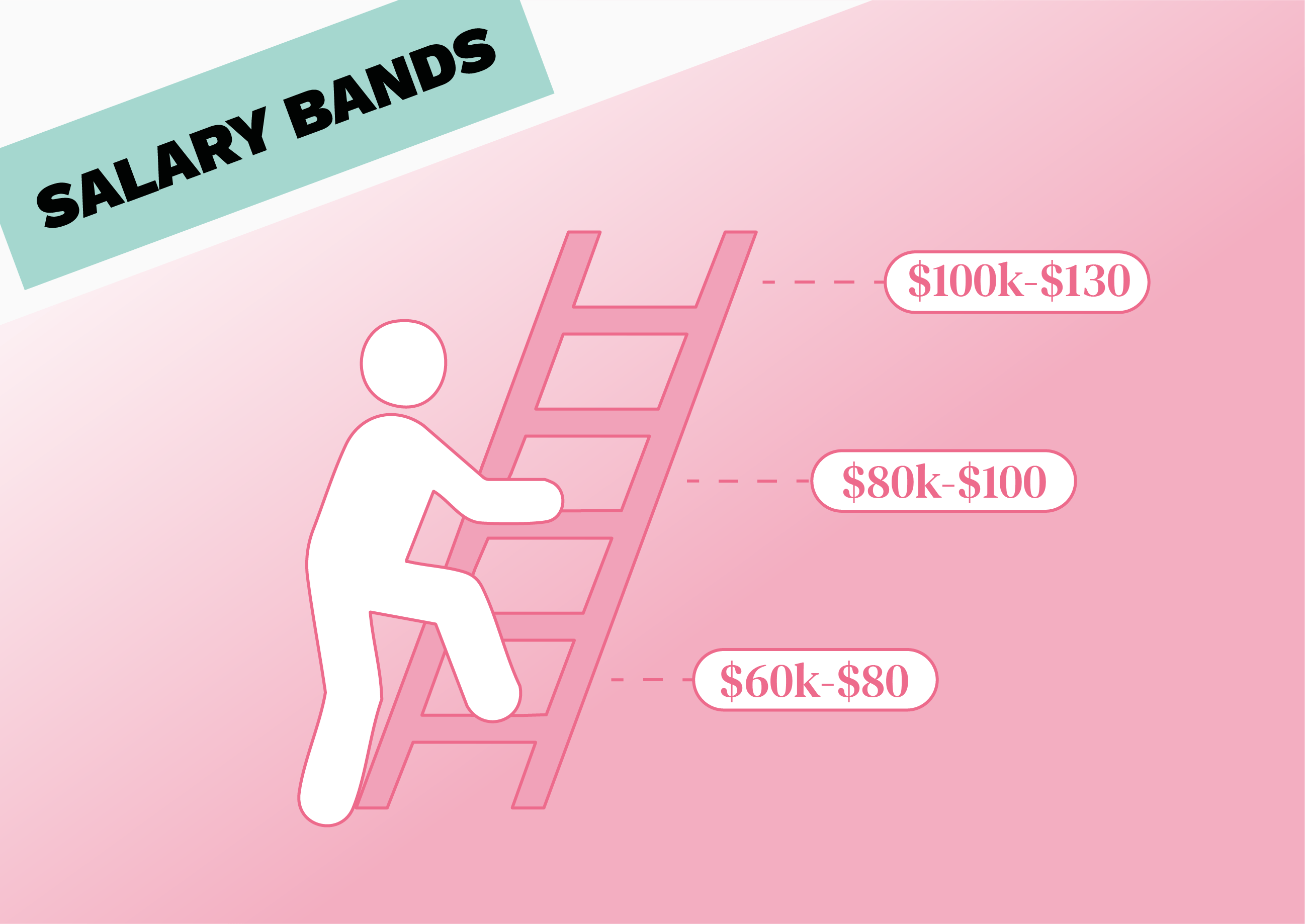If you’ve already created a robust and structured salary band system, defining a salary for a new employee usually isn’t too difficult. After all, the whole reason for creating salary bands is to provide a consistent, structured framework for pay decisions. But what if you’re hiring for a role that doesn’t yet exist in your organisation?
Companies do sometimes create salary bands for positions that don’t exist yet, based on their future hiring goals. However, it’s much more common to create salary bands for the roles you already have, and then add new ones over time. We’ll take you through that process in this article.
Note: If you haven’t yet created your salary band structure, this probably isn’t the article for you — check out our ultimate salary band checklist instead!
5 steps to create a new salary band within your existing structure
Hiring for a new role that doesn’t yet have a salary band? Here are the steps to follow to create one.
1. Define the scope and requirements of the role
The first step in setting the right salary for a new role is to define exactly what that role will look like. You should consider things like:
- The responsibilities the role involves
- The key skills and competencies required
- The qualifications or certifications the ideal candidate will have
- How business-impacting the role is
It’s also important to think about how the role will sit alongside other roles, both within the same team and in the wider organisation. Answering these questions will allow you to place your new role on your existing levelling framework.
2. Consider the role in relation to your existing salaries
Next, you should consider the role in relation to other existing positions within your organisation. After all, even if the position itself is new, there may be other jobs that are comparable.
It’s important to keep in mind that, under the EU pay transparency directive, employers will need to be able to demonstrate equal pay for roles that are of ‘equal value’. Theoretically, an employee who is paid less than a colleague in an equivalent role could use that colleague as a comparator in an equal pay case, even if their actual job titles are different.
Thinking about your new salary from an internal equity perspective at this early stage can help you avoid big problems down the line.
{{cta}}
3. Conduct external salary benchmarking
If you want to offer a competitive salary that will attract top candidates, salary benchmarking is crucial. Put simply, this is the process of identifying what other companies pay for similar positions. To get an accurate idea of the market, it’s a good idea to benchmark against companies that are similar to yours, for example in terms of size, industry, location or funding stage.
There are a few different ways of finding salary data for benchmarking, including paying for industry reports or relying on self-reported sources like Glassdoor. But, in our humble opinion, the best option is to use a tool like Figures, which gives you instant access to real-time, accurate and filterable market data.
4. Determine your ideal market positioning
Figuring out the market median for a role through salary benchmarking is a solid starting point for building your new salary band. However, keep in mind that this is just the midpoint of the market — there’s nothing to say you can’t pay more (or less). That’s why the next step is deciding where you want to position your salary compared to the market.
For example, some companies decide to pay above-market rates, which can help them to attract the best talent. Startups or small companies might need to pay below-market, but they can often sweeten the deal with additional perks, benefits or equity.
Of course, your ideal positioning might already have been defined as part of your overall compensation strategy — in which case, your job is easy. But in some cases, you might need to position yourself differently for certain roles in order to attract the right candidates.
{{cta}}
5. Decide on the right width for the salary band
The positioning you decide on for the new role will be the midpoint of your salary band. But the whole point of a salary band is that it’s not a set figure, but a range that provides flexibility and room for progression.
Deciding on the right width for your new salary band is the next step in the process. Again, this might be defined by your overall salary band structure, which might specify a width for all bands. But some companies use different widths for different bands.
For example, one common approach is to have salary bands widening as you move up the levels. This is because it typically takes longer to progress from Senior to Staff level than from Junior to Intermediate, for example, and having wider salary bands at the higher levels allows room for employees to progress within their band. If you choose this approach, your salary band width might depend on the level of the job you’re hiring for.
Need extra help with this step? You can read more in our guide to setting the right width for your salary bands.
Defining the new employee’s salary within the range
Here’s the scenario: you’ve created your new salary band, advertised the role and found the perfect candidate for the job. Nice work!
Now, all that’s left is to decide what salary to offer them within the range provided by the salary band. This doesn’t have to be too complicated, but it does require some thought.
First, if you’ve done the groundwork while creating your overall salary band structure, you should already have set criteria for each level. By assessing the candidate against those criteria, you can begin to determine where they should sit within their band. For example, if the role represents a big jump up for the candidate, it might make sense to position them near the bottom of the band.
For more experienced candidates, placing them higher up in the band probably makes more sense. However, it’s important to be careful here: the higher up an employee is within their band, the less room there is for progression without a promotion to the next level. Although it might seem counterintuitive, offering a lower salary to begin with and then giving a 5–10% raise each year could be better for morale overall.
{{cta}}
Should you leave room for negotiation?
In some companies, negotiating salaries with candidates is a key part of the hiring process. And having a little wiggle room in the salaries you offer can be a good thing if it helps you to land top talent.
But companies that take this approach need to be careful, as leaving too much room for negotiation could introduce the possibility of inequitable pay. For example, imagine you have two employees in the same role, at the same level, with equivalent skills and experience. Is it fair that one of them is paid more than the other just because they happen to be better at negotiating?
The good news is that using salary bands to define your salaries inherently makes the negotiation process fairer since every employee’s pay will sit within a defined range for their role and level. If you do allow for negotiation, it could be a good idea to give candidates a slightly lower starting offer but have a fixed maximum in mind during negotiations. Keeping a close eye on your internal equity through regular compensation reviews can also help you avoid major problems.
The importance of accurate salary ranges
If you’re a regular on this blog, you’ll know that the EU pay transparency directive is just around the corner. And, once it comes into play in 2026, employers will have to make some big changes to the way they handle compensation.
Specifically, employers will have to share salary ranges with job candidates before the interview stage, usually by including them in their job descriptions. Companies will also need to be able to show that their compensation framework is built on fair, consistent criteria — or they could face claims for pay inequity.
That means you need to be confident in your salary bands and comfortable sharing them with the general public. Laying the groundwork now by creating a robust, scalable salary structure will help to ensure you’re prepared once the new legislation rolls around.
Summarize this article with AI
No time to read it all? Get a clear, structured, and actionable summary in one click.






